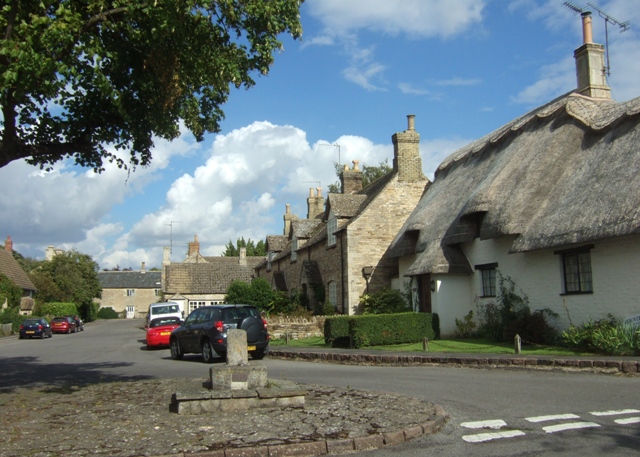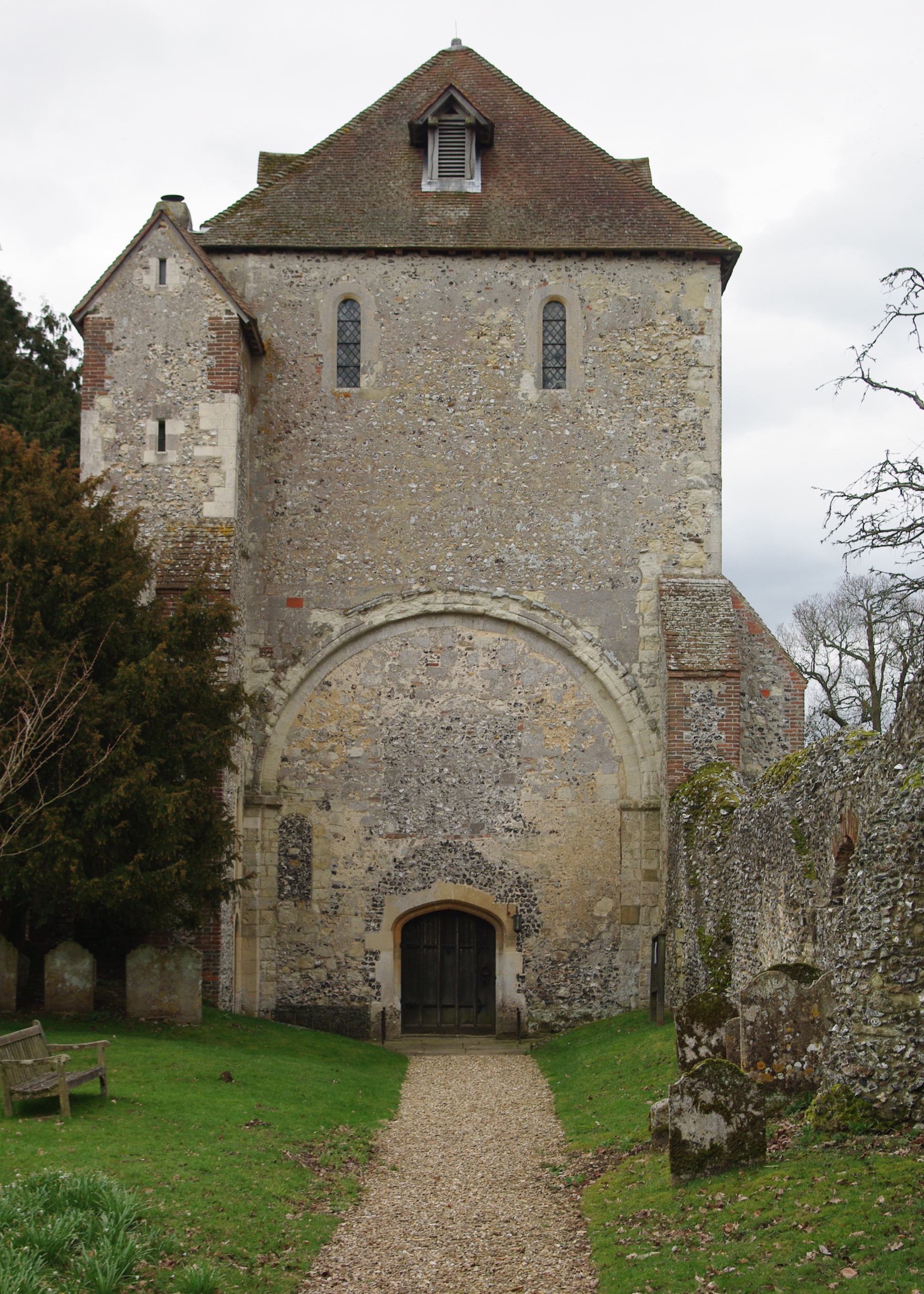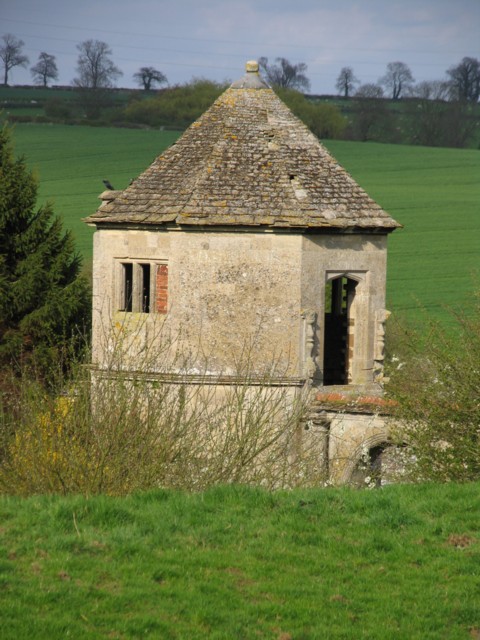|
Edith Weston Priory
Edith Weston Priory was a small alien house of Benedictine monks in Edith Weston, Rutland. The French parent house of Abbey of Saint-Georges, Boscherville was founded by Ralf de Tanquerville, chamberlain to William the Conqueror, about the year 1050. By 1114 his son William donated the church and manor at Edith Weston, and a small cell of monks was set up to collect the rents and intercede for the founder's soul. The cell was one of two in England: William founded Avebury Priory in Wiltshire around the same time. Like all alien houses, control (and revenues) passed to the Crown in time of war with France, and it was during one of these periods that the priory closed. The last known Prior was in 1361, and by 1394 the church and manor had been sold to St. Anne's Priory, Coventry, bringing the priory to an end. Pevsner was dismissive of the priory, saying that Brooke Priory was the only monastery in Rutland as "Edith Weston hardly counts as one". The earthwork remains probably no ... [...More Info...] [...Related Items...] OR: [Wikipedia] [Google] [Baidu] |
Rutland Water
Rutland Water is a reservoir in Rutland, England, east of Rutland's county town, Oakham. It is filled by pumping from the River Nene and River Welland, and provides water to the East Midlands. By surface area it is the largest reservoir in England, but its capacity is exceeded by that of Kielder Water in Northumberland. Its maximum depth is 33m (108 ft). Set in of countryside, it has a perimeter track, ( excluding Hambleton Peninsula) for walking or cycling. Since the water is drawn upon when needed, the relative areas of land and water vary a little, but the flatter parts of the lake margin are enclosed by banks so that the wetland nature reserve is maintained (). A 1,555 hectare area of lake and shore is a biological Site of Special Scientific Interest, a Special Protection Area under the European Union Directive on the Conservation of Wild Birds and Nature Conservation Review site. An area of 1,333 hectares is a Ramsar internationally important wetland site, and 393 he ... [...More Info...] [...Related Items...] OR: [Wikipedia] [Google] [Baidu] |
Benedictine
, image = Medalla San Benito.PNG , caption = Design on the obverse side of the Saint Benedict Medal , abbreviation = OSB , formation = , motto = (English: 'Pray and Work') , founder = Benedict of Nursia , founding_location = Subiaco Abbey , type = Catholic religious order , headquarters = Sant'Anselmo all'Aventino , num_members = 6,802 (3,419 priests) as of 2020 , leader_title = Abbot Primate , leader_name = Gregory Polan, OSB , main_organ = Benedictine Confederation , parent_organization = Catholic Church , website = The Benedictines, officially the Order of Saint Benedict ( la, Ordo Sancti Benedicti, abbreviated as OSB), are a monastic religious order of the Catholic Church following the Rule of Saint Benedict. They are also sometimes called the Black Monks, in reference to the colour of their religious habits. They ... [...More Info...] [...Related Items...] OR: [Wikipedia] [Google] [Baidu] |
Abbey Of Saint-Georges, Boscherville
The Abbey of Saint-Georges, Boscherville, is a former Benedictine abbey located in the commune of Saint-Martin-de-Boscherville, in Seine-Maritime, France. It was founded in about 1113 on the site of an earlier establishment of secular canons and settled by monks from the Abbey of Saint-Evroul The Abbey of Saint-Evroul or Saint-Evroul-sur-Ouche (''Saint-Evroult-sur-Ouche, Saint-Evroul-en-Ouche, Saint-Evroult-en-Ouche, Abbaye de Saint-Evroult, Sanctus Ebrulphus Uticensis '') is a former Benedictine abbey in Normandy, located in the present .... References External links Abbaye Saint-Georges Benedictine monasteries in France Buildings and structures in Seine-Maritime Churches in Seine-Maritime Tourist attractions in Seine-Maritime Gardens in Seine-Maritime Romanesque architecture in Normandy Christian monasteries established in the 12th century 1113 establishments in Europe 1110s establishments in France {{France-church-stub ... [...More Info...] [...Related Items...] OR: [Wikipedia] [Google] [Baidu] |
Diocese Of Lincoln
The Diocese of Lincoln forms part of the Province of Canterbury in England. The present diocese covers the ceremonial county of Lincolnshire. History The diocese traces its roots in an unbroken line to the Pre-Reformation Diocese of Leicester, founded in 679. The see of Leicester was translated to Dorchester in the late 9th century, before taking in the territory of the Diocese of Lindsey and being translated to Lincoln. The diocese was then the largest in England, extending from the River Thames to the Humber Estuary. In 1072, Remigius de Fécamp, bishop under William the Conqueror, moved the see to Lincoln, although the Bishops of Lincoln retained significant landholdings within Oxfordshire. Because of this historic link, for a long time Banbury remained a peculiar of the Bishop of Lincoln. The modern diocese remains notoriously extensive, having been reportedly referred to by Bob Hardy, Bishop of Lincoln, as "2,000 square miles of bugger all" in 2002. The dioceses of ... [...More Info...] [...Related Items...] OR: [Wikipedia] [Google] [Baidu] |
Edith Weston
Edith Weston is a village and civil parish in the county of Rutland in the East Midlands of England. The population of the civil parish was 1,042 at the 2001 census, including Normanton and increasing to 1,359 at the 2011 census. It is on the south-eastern shore of Rutland Water and is home of the main sailing club and a fishing lodge. The village is named after Edith of Wessex (1029–1075), the queen of Edward the Confessor and sister of Harold Godwinson. The Grade I listed church is dedicated to St Mary the Virgin and includes stained glass by Paul Woodroffe and Hugh Arnold; the organ is by Samuel Green of London and dated 1787. The village pub is the Wheatsheaf on King Edward's Way. St George's Barracks is located to the south and east of the village; this was previously RAF North Luffenham. In August 2007 16th Regiment Royal Artillery, equipped with the Rapier FSC, moved here from Woolwich. Edith Weston features in the Alan Sillitoe novel ''Down From the Hill ... [...More Info...] [...Related Items...] OR: [Wikipedia] [Google] [Baidu] |
Rutland
Rutland () is a ceremonial county and unitary authority in the East Midlands, England. The county is bounded to the west and north by Leicestershire, to the northeast by Lincolnshire and the southeast by Northamptonshire. Its greatest length north to south is only and its greatest breadth east to west is . It is the smallest historic county in England and the fourth smallest in the UK as a whole. Because of this, the Latin motto ''Multum in Parvo'' or "much in little" was adopted by the county council in 1950. It has the smallest population of any normal unitary authority in England. Among the current ceremonial counties, the Isle of Wight, City of London and City of Bristol are smaller in area. The former County of London, in existence 1889 to 1965, also had a smaller area. It is 323rd of the 326 districts in population. The only towns in Rutland are Oakham, the county town, and Uppingham. At the centre of the county is Rutland Water, a large artificial reservoir th ... [...More Info...] [...Related Items...] OR: [Wikipedia] [Google] [Baidu] |
Alien House
Alien priories were religious establishments in England, such as monasteries and convents, which were under the control of another religious house outside England. Usually the mother-house was in France.Coredon ''Dictionary of Medieval Terms'' p. 10 History Alien Priories were small dependencies of foreign religious houses. Specifically, this pertained to the English possessions of French religious houses. The precedent went back at least as far as 912. Ælfthryth, daughter of Alfred the Great married Baldwin II, Count of Flanders. She received various properties under her father's will, and gave Lewisham Priory with its dependencies, Greenwich and Woolwich, to the abbey of St Peter at Ghent. Edward the Confessor gave the parish church at Deerhurst, and its lands to the monastery of St Denis. The practice increased after the Norman Conquest. A number of Norman lords had founded monasteries on their lands in France, which in many cases sent monks to England to manage their ... [...More Info...] [...Related Items...] OR: [Wikipedia] [Google] [Baidu] |
William The Conqueror
William I; ang, WillelmI (Bates ''William the Conqueror'' p. 33– 9 September 1087), usually known as William the Conqueror and sometimes William the Bastard, was the first House of Normandy, Norman List of English monarchs#House of Normandy, king of England, reigning from 1066 until his death in 1087. A descendant of Rollo, he was Duke of Normandy from 1035 onward. By 1060, following a long struggle to establish his throne, his hold on Normandy was secure. In 1066, following the death of Edward the Confessor, William invaded England, leading an army of Normans to victory over the Anglo-Saxons, Anglo-Saxon forces of Harold Godwinson at the Battle of Hastings, and suppressed subsequent English revolts in what has become known as the Norman Conquest. The rest of his life was marked by struggles to consolidate his hold over England and his continental lands, and by difficulties with his eldest son, Robert Curthose. William was the son of the unmarried Duke Robert I of Normandy ... [...More Info...] [...Related Items...] OR: [Wikipedia] [Google] [Baidu] |
Avebury Priory
Avebury Priory was an alien house of Benedictine monks in Wiltshire, England, between the early 12th century and the Dissolution. William de Tancarville, chamberlain to Henry I, granted an Avebury estate (which he had recently received from the King) to the Abbey of Saint-Georges, Boscherville, Normandy in 1114, and a priory was established at Avebury soon afterwards. It was one of two such cells in England: William had also donated the church and manor at Edith Weston, Rutland, in or before the same year, leading to the establishment of Edith Weston Priory. At Avebury the monks did not have control of the parish church which was held by Cirencester Abbey, causing disputes over tithes in the next century. An inventory made in 1324 found around 600 sheep, two horses and two beds; the abbey typically had three or four monks in England, divided between Avebury and Edith Weston. Most foreign monks were expelled in 1378, and thereafter the land was tenanted by a succession of royal s ... [...More Info...] [...Related Items...] OR: [Wikipedia] [Google] [Baidu] |
Victoria County History
The Victoria History of the Counties of England, commonly known as the Victoria County History or the VCH, is an English history project which began in 1899 with the aim of creating an encyclopaedic history of each of the historic counties of England, and was dedicated to Victoria of the United Kingdom, Queen Victoria. In 2012 the project was rededicated to Elizabeth II, Queen Elizabeth II in celebration of her Diamond Jubilee year. Since 1933 the project has been coordinated by the Institute of Historical Research in the University of London. History The history of the VCH falls into three main phases, defined by different funding regimes: an early phase, 1899–1914, when the project was conceived as a commercial enterprise, and progress was rapid; a second more desultory phase, 1914–1947, when relatively little progress was made; and the third phase beginning in 1947, when, under the auspices of the Institute of Historical Research, a high academic standard was set, and pr ... [...More Info...] [...Related Items...] OR: [Wikipedia] [Google] [Baidu] |
Nikolaus Pevsner
Sir Nikolaus Bernhard Leon Pevsner (30 January 1902 – 18 August 1983) was a German-British art historian and architectural historian best known for his monumental 46-volume series of county-by-county guides, ''The Buildings of England'' (1951–74). Life Nikolaus Pevsner was born in Leipzig, Saxony, the son of Anna and her husband Hugo Pevsner, a Russian-Jewish fur merchant. He attended St. Thomas School, Leipzig, and went on to study at several universities, Munich, Berlin, and Frankfurt am Main, before being awarded a doctorate by Leipzig in 1924 for a thesis on the Baroque architecture of Leipzig. In 1923, he married Carola ("Lola") Kurlbaum, the daughter of distinguished Leipzig lawyer Alfred Kurlbaum. He worked as an assistant keeper at the Dresden Gallery between 1924 and 1928. He converted from Judaism to Lutheranism early in his life. During this period he became interested in establishing the supremacy of German modernist architecture after becoming aware of Le ... [...More Info...] [...Related Items...] OR: [Wikipedia] [Google] [Baidu] |
Brooke Priory
Brooke Priory was a minor house of Augustinian monks in Brooke, Rutland. It was a cell of St Mary's Abbey, Kenilworth. History It was founded by Hugh de Ferrers (lord of the manor of Oakham) before 1153. It was dedicated to St Mary the Virgin,. The house was built close to the River Gwash which gave the parish its name. It was only a small priory, and only intended to support three canons. The priory struggled financially, and had a rapid succession of priors who felt unable to deal with the priory's poverty. Many saw being sent to Brooke as something of a punishment. In 1298 the Bishop of Lincoln wrote to the Prior of Kenilworth urging him to take action about Brooke. The priory had become "so dilapidated and decayed that it was a scandal to the neighbourhood, and the revenues were so mismanaged that if something was not done soon the canons and their servants would have to beg their bread". The final prior, Roger Harwell, was in a dispute with his superiors at Kenilworth. H ... [...More Info...] [...Related Items...] OR: [Wikipedia] [Google] [Baidu] |
.jpg)






